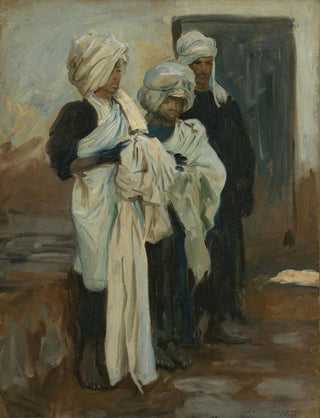Egyptian Indigo Dyed Art print | John Singer Sargent


View from behind

Frame (optional)
In the fascinating world of painting, some artworks transcend the simple frame of art to become visual stories, windows opened onto distant cultures and bygone eras. "Reproduction Teinturiers à l'indigo égyptiens - John Singer Sargent" is a perfect example. This piece, which captures the vibrant essence of Egypt through the lens of American artist John Singer Sargent, transports us to the heart of an ancient artisanal activity. The artwork invites us to discover the nuances of the daily life of dyers, while revealing the beauty and richness of the colors emanating from this process. Sargent, with his unparalleled talent, manages to immortalize not only a moment but also the soul of a people, thus paying tribute to a traditional craftsmanship.
Style and uniqueness of the artwork
Sargent's style, characterized by his painting technique that is both precise and free, is fully expressed in this piece. Light plays a central role, illuminating the faces of the dyers and the deep nuances of indigo, creating a striking contrast. The meticulous details, from the folds of clothing to the textures of fabrics, testify to attentive observation and exceptional technical mastery. Sargent succeeds in capturing not only the appearance of the subjects but also their essence, dignity, and concentration. The use of rich and vibrant colors, typical of the artist, contributes to an almost palpable atmosphere, where one can almost smell the dyes and hear the whispers of artisans at work. Thus, this artwork stands out for its ability to evoke a complete sensory experience, immersing the viewer in a world where art and craftsmanship meet.
The artist and his influence
John Singer Sargent, born in 1856, is often considered one of the most prolific portraitists of his time. However, his work goes far beyond bourgeois portraits of the late 19th century. Traveling across Europe and the Middle East, he absorbed the cultures he encountered, integrating their influences into his own style. "Reproduction Teinturiers à l'indigo égyptiens" illustrates this curiosity

Matte finish

View from behind

Frame (optional)
In the fascinating world of painting, some artworks transcend the simple frame of art to become visual stories, windows opened onto distant cultures and bygone eras. "Reproduction Teinturiers à l'indigo égyptiens - John Singer Sargent" is a perfect example. This piece, which captures the vibrant essence of Egypt through the lens of American artist John Singer Sargent, transports us to the heart of an ancient artisanal activity. The artwork invites us to discover the nuances of the daily life of dyers, while revealing the beauty and richness of the colors emanating from this process. Sargent, with his unparalleled talent, manages to immortalize not only a moment but also the soul of a people, thus paying tribute to a traditional craftsmanship.
Style and uniqueness of the artwork
Sargent's style, characterized by his painting technique that is both precise and free, is fully expressed in this piece. Light plays a central role, illuminating the faces of the dyers and the deep nuances of indigo, creating a striking contrast. The meticulous details, from the folds of clothing to the textures of fabrics, testify to attentive observation and exceptional technical mastery. Sargent succeeds in capturing not only the appearance of the subjects but also their essence, dignity, and concentration. The use of rich and vibrant colors, typical of the artist, contributes to an almost palpable atmosphere, where one can almost smell the dyes and hear the whispers of artisans at work. Thus, this artwork stands out for its ability to evoke a complete sensory experience, immersing the viewer in a world where art and craftsmanship meet.
The artist and his influence
John Singer Sargent, born in 1856, is often considered one of the most prolific portraitists of his time. However, his work goes far beyond bourgeois portraits of the late 19th century. Traveling across Europe and the Middle East, he absorbed the cultures he encountered, integrating their influences into his own style. "Reproduction Teinturiers à l'indigo égyptiens" illustrates this curiosity






